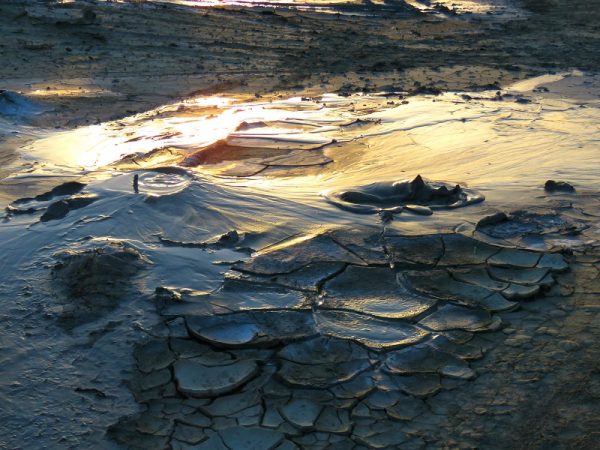Each volcano has a life path with which it was born and then slowly dies. Very often these two extreme moments in the existence of these unique mountains are given by secondary phenomena. That is, by eruptions without fire but with other materials. Sometimes they are boiling water jets, the famous geysers. Other times they are springs of sulphurous water or hot muds. In Sicily there are several ancient and modern volcanoes, as well as many secondary eruptive phenomena (except geysers).
The Salinelle of Etna are an example of this. And so are the Maccalube, the mud fountains located in the center of Sicily. In appearance … only in appearance! … they are far from any volcano. In many occasions these phenomena look similar, almost the same sometimes. But are they really the same? And if not, how do they differ?
The Salinelle of Etna
Located mainly in the Paternò area, divided into several sites, the Salinelle of Etna are micro volcanoes. They periodically emit sulphurous waters and muds. Depending on the degree of activity in progress, jets of clear water are emitted from the pools. Each individual fountain however brings tiny crystals of sulfur salts. This is why, when the water evaporates, brightly coloured crystals (green, yellow, orange) remain on the ground. At other times, the water is strongly mixed with the clay and therefore the fountains emit jets of blue-gray mud. It then solidifies, forming a new walkable surface.
The phenomenon of the Salinelle derives from an ancient magmatic conduit that several centuries ago created the lava hill on which today the town of Paternò stands. Even today, the ground is boiling here and there. Sometimes new “fountains” casually open up in the city … in a garage, in a block of flat’s garden. The officially recognized sites of the Salinelle are: Salinelle dei Cappuccini, all around the football stadium of Paternò; Salinelle del Fiume, close to the Simeto river; Salinelle San Biagio, which take their name from the uncultivated land in the nearby municipality of Belpasso.
The Maccalube
 the maccalubes at Santa Barbara, Caltanissetta
the maccalubes at Santa Barbara, Caltanissetta
The word Maccaluba comes from the ancient Arabic, maqlùb, and means “upside down”. In the Islamic culinary tradition it is also the name of a dish based on meat and vegetables which, after cooking, is turned upside down. So you can consume for first the ingredients you had added last. Associated with the volcanic phenomena of the area between Caltanissetta and Agrigento, the word “upside down” indicates precisely the overturning of the soil that causes the mud eruption.
The mud erupted by these volcanoes comes from the meeting, in depth, of clay, sea water and volcanic gases. During the ascent the muddy flow is enriched with other materials and when it erupts it is very dense and heavy. The Maccalube are unpredictable. They can erupt small splashes of mud for years and then give way to a “major eruption” with very high mud jets. In the recent past they have also caused victims. Sometimes the mud overflows and invades the surrounding streets and fields.
The most famous sites of the Maccalube are located in Aragona (Agrigento), in a protected nature reserve; in the Terrapelata-Santa Barbara site, outskirts of Caltanissetta; in the Floristella hamlet (Enna). Apparently these mud volcanoes are very far from any other Sicilian volcano. But take a look at the imaginary line that unites the Aeolian Islands, Etna, the former volcano Monte Kronio di Sciacca and the submerged island Ferdinandea. You will see that it is a perfect diagonal, at the center of which there are the Maccalube!
Similarities and differences
The similarities between the Salinelle and the Maccalube are many. In both cases, these are volcanoes that emit secondary eruptions. Both expel mud mixed with gas and sulfur. Both are evidence of ancient volcanoes now in the process of being extinguished.
The Salinelle however tend to emit water more often, rather than mud. They are connected, although not directly, with the activity of nearby Etna. They rarely emit jets that are dangerous to humans, although it is always good to stay at a distance. The Maccalube instead can cause important eruptions, with very high jets and considerable mud flows.
However, these are volcanic phenomena and – whether they are dangerous or not – they must be faced with caution and intelligence. Always follow the wise advice of the guides or warning signs for tourists. Nature never kills, if you don’t openly challenge it!
Visit the Salinelle and the Maccalube
The Salinelleof Etna, in Paternò and Belpasso, are freely accessible. For some time now, attempts have been made to transform the Salinelle dei Cappuccini, at the stadium, into a protected and controlled reserve. But nothing has yet been built except for signs. To get there: see this link with the necessary information.
The Maccalube, on the other hand, are a protected reserve in the Aragon area. They can be reached freely in the other sites. To get to the reserve, and to learn about other practical information on the spot, visit the official website. (PHOTO BY GRAZIA MUSUMECI)